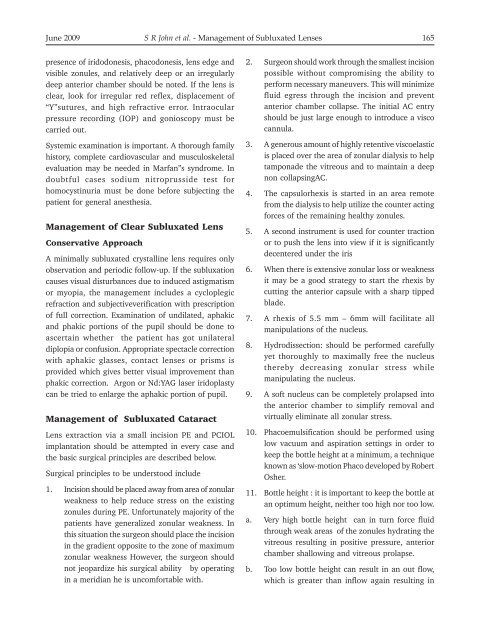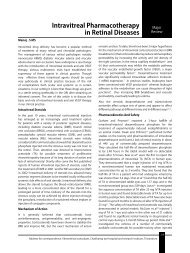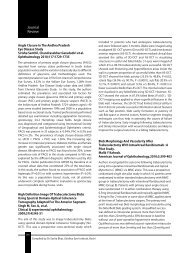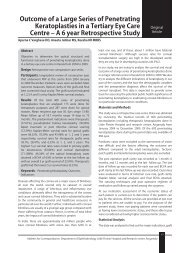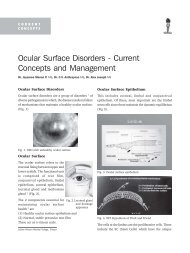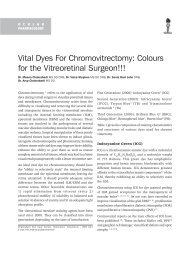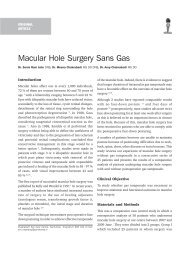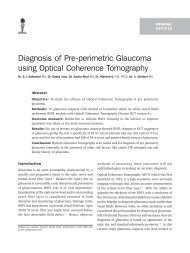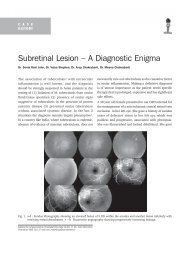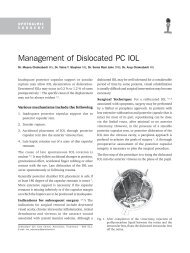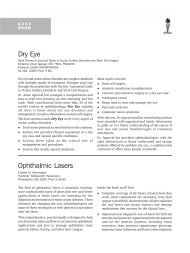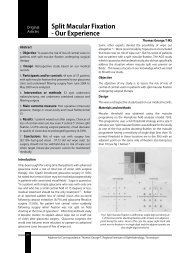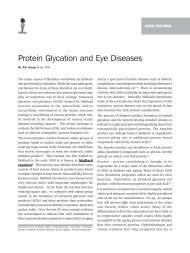Management of Subluxated Lenses - KSOS
Management of Subluxated Lenses - KSOS
Management of Subluxated Lenses - KSOS
Create successful ePaper yourself
Turn your PDF publications into a flip-book with our unique Google optimized e-Paper software.
June 2009 S R John et al. - <strong>Management</strong> <strong>of</strong> <strong>Subluxated</strong> <strong>Lenses</strong> 165<br />
presence <strong>of</strong> iridodonesis, phacodonesis, lens edge and<br />
visible zonules, and relatively deep or an irregularly<br />
deep anterior chamber should be noted. If the lens is<br />
clear, look for irregular red reflex, displacement <strong>of</strong><br />
“Y”sutures, and high refractive error. Intraocular<br />
pressure recording (IOP) and gonioscopy must be<br />
carried out.<br />
Systemic examination is important. A thorough family<br />
history, complete cardiovascular and musculoskeletal<br />
evaluation may be needed in Marfan”s syndrome. In<br />
doubtful cases sodium nitroprusside test for<br />
homocystinuria must be done before subjecting the<br />
patient for general anesthesia.<br />
<strong>Management</strong> <strong>of</strong> Clear <strong>Subluxated</strong> Lens<br />
Conservative Approach<br />
A minimally subluxated crystalline lens requires only<br />
observation and periodic follow-up. If the subluxation<br />
causes visual disturbances due to induced astigmatism<br />
or myopia, the management includes a cycloplegic<br />
refraction and subjectiveverification with prescription<br />
<strong>of</strong> full correction. Examination <strong>of</strong> undilated, aphakic<br />
and phakic portions <strong>of</strong> the pupil should be done to<br />
ascertain whether the patient has got unilateral<br />
diplopia or confusion. Appropriate spectacle correction<br />
with aphakic glasses, contact lenses or prisms is<br />
provided which gives better visual improvement than<br />
phakic correction. Argon or Nd:YAG laser iridoplasty<br />
can be tried to enlarge the aphakic portion <strong>of</strong> pupil.<br />
<strong>Management</strong> <strong>of</strong> <strong>Subluxated</strong> Cataract<br />
Lens extraction via a small incision PE and PCIOL<br />
implantation should be attempted in every case and<br />
the basic surgical principles are described below.<br />
Surgical principles to be understood include<br />
1. Incision should be placed away from area <strong>of</strong> zonular<br />
weakness to help reduce stress on the existing<br />
zonules during PE. Unfortunately majority <strong>of</strong> the<br />
patients have generalized zonular weakness. In<br />
this situation the surgeon should place the incision<br />
in the gradient opposite to the zone <strong>of</strong> maximum<br />
zonular weakness However, the surgeon should<br />
not jeopardize his surgical ability by operating<br />
in a meridian he is uncomfortable with.<br />
2. Surgeon should work through the smallest incision<br />
possible without compromising the ability to<br />
perform necessary maneuvers. This will minimize<br />
fluid egress through the incision and prevent<br />
anterior chamber collapse. The initial AC entry<br />
should be just large enough to introduce a visco<br />
cannula.<br />
3. A generous amount <strong>of</strong> highly retentive viscoelastic<br />
is placed over the area <strong>of</strong> zonular dialysis to help<br />
tamponade the vitreous and to maintain a deep<br />
non collapsingAC.<br />
4. The capsulorhexis is started in an area remote<br />
from the dialysis to help utilize the counter acting<br />
forces <strong>of</strong> the remaining healthy zonules.<br />
5. A second instrument is used for counter traction<br />
or to push the lens into view if it is significantly<br />
decentered under the iris<br />
6. When there is extensive zonular loss or weakness<br />
it may be a good strategy to start the rhexis by<br />
cutting the anterior capsule with a sharp tipped<br />
blade.<br />
7. A rhexis <strong>of</strong> 5.5 mm – 6mm will facilitate all<br />
manipulations <strong>of</strong> the nucleus.<br />
8. Hydrodissection: should be performed carefully<br />
yet thoroughly to maximally free the nucleus<br />
thereby decreasing zonular stress while<br />
manipulating the nucleus.<br />
9. A s<strong>of</strong>t nucleus can be completely prolapsed into<br />
the anterior chamber to simplify removal and<br />
virtually eliminate all zonular stress.<br />
10. Phacoemulsification should be performed using<br />
low vacuum and aspiration settings in order to<br />
keep the bottle height at a minimum, a technique<br />
known as ‘slow-motion Phaco developed by Robert<br />
Osher.<br />
11. Bottle height : it is important to keep the bottle at<br />
an optimum height, neither too high nor too low.<br />
a. Very high bottle height can in turn force fluid<br />
through weak areas <strong>of</strong> the zonules hydrating the<br />
vitreous resulting in positive pressure, anterior<br />
chamber shallowing and vitreous prolapse.<br />
b. Too low bottle height can result in an out flow,<br />
which is greater than inflow again resulting in


